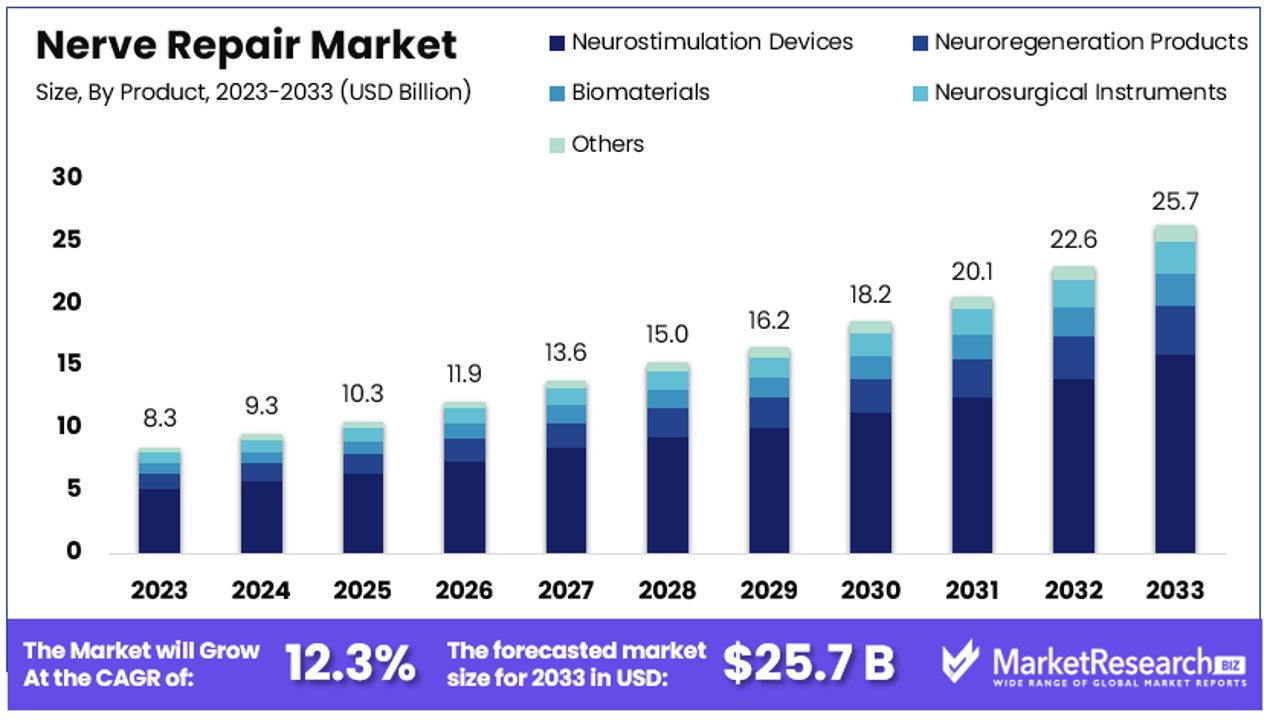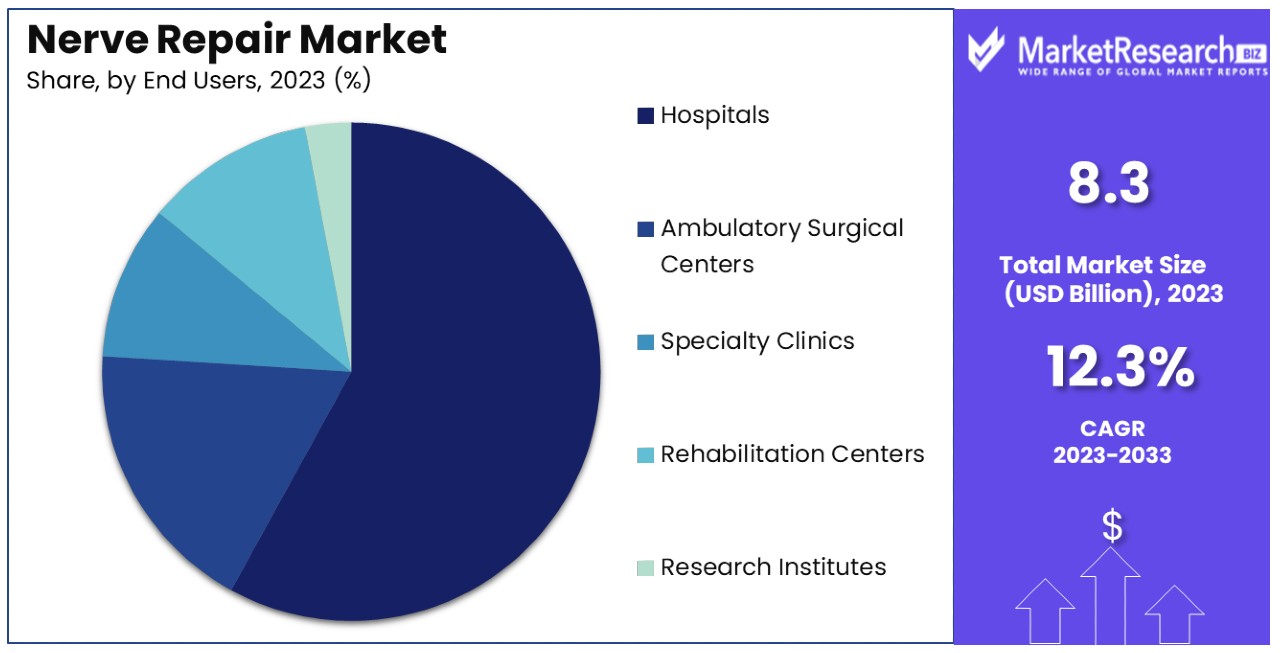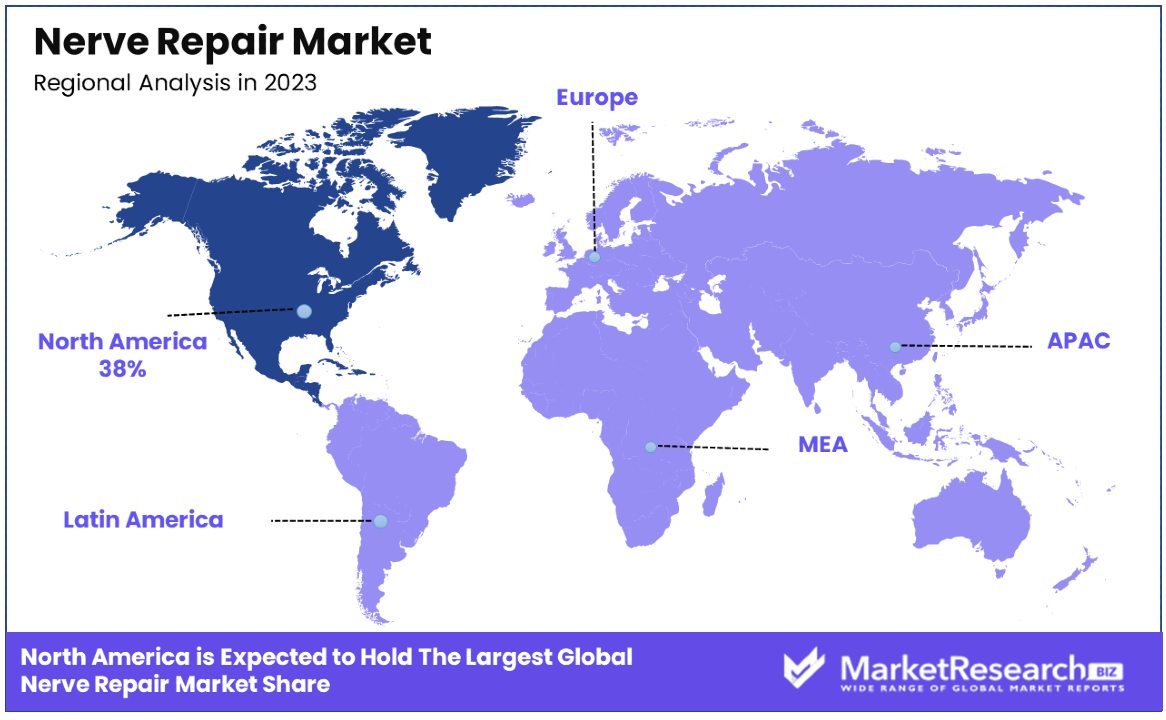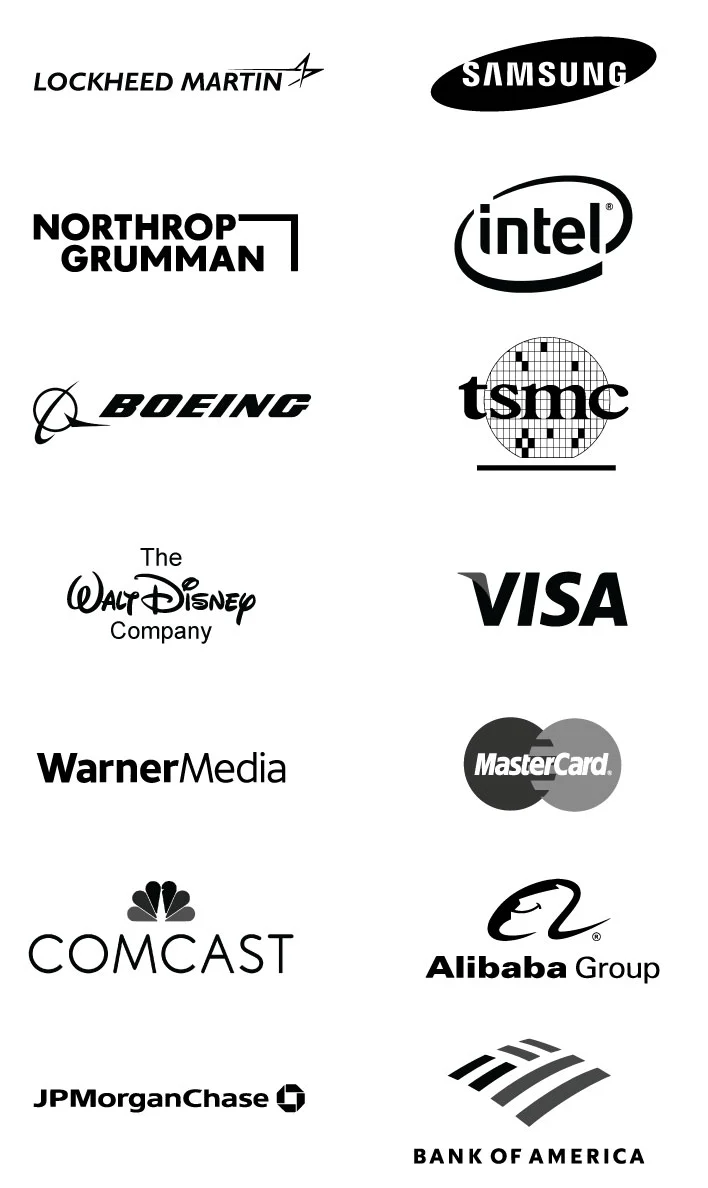
Nerve Repair Market Report By Nerve Repair Products (Neurostimulation Devices, Neuroregeneration Products, Biomaterials (e.g., Nerve Conduits, Nerve Wraps), Neurosurgical Instruments, Others), By Surgery (Direct Nerve Repair/Neurorrhaphy, Nerve Grafting, Stem Cell Therapy, Gene Therapy, Neurostimulation and Neuromodulation Surgeries), By End Users, By Region and Companies - Industry Segment Outlook, Market Assessment, Competition Scenario, Trends and Forecast 2024-2033
-
45696
-
May 2024
-
319
-
-
This report was compiled by Trishita Deb Trishita Deb is an experienced market research and consulting professional with over 7 years of expertise across healthcare, consumer goods, and materials, contributing to over 400 healthcare-related reports. Correspondence Team Lead- Healthcare Linkedin | Detailed Market research Methodology Our methodology involves a mix of primary research, including interviews with leading mental health experts, and secondary research from reputable medical journals and databases. View Detailed Methodology Page
-
Quick Navigation
Report Overview
The Global Nerve Repair Market size is expected to be worth around USD 25.7 Billion by 2033, from USD 8.3 Billion in 2023, growing at a CAGR of 12.3% during the forecast period from 2024 to 2033.
The Nerve Repair Market encompasses the medical solutions, technologies, and procedures dedicated to the restoration of nerve function lost due to injuries or disorders. This market includes nerve repair and regeneration products such as biomaterials, neurostimulation and neuromodulation devices, and surgical instruments.
The focus is on enhancing patient recovery and improving outcomes in conditions involving peripheral nerves. As this sector advances, it offers significant potential for healthcare providers and medical device companies. This market is pivotal for stakeholders aiming to lead in innovative healthcare solutions.

This market is projected to expand significantly, driven by advancements in technology, increasing incidence of nerve-related injuries, and a rising aging population susceptible to neurodegenerative disorders.
The market's growth is underpinned by a surge in demand for effective therapeutic solutions, which is propelled by enhanced surgical techniques and a deeper understanding of nerve biology. Innovations in neurostimulation and biodegradable conduits are revolutionizing the approach to nerve repair, making interventions more efficient and less invasive.
Furthermore, regulatory support for rapid device approval has fostered a favorable environment for market players. The financial landscape is also witnessing substantial investments from both public and private sectors, aiming to push the boundaries of what's possible in nerve repair.
Economic indicators suggest a promising return on investment within this sector. With an anticipated compound annual growth rate (CAGR) of approximately 12.3% over the next decade, stakeholders are keenly interested in harnessing this potential. The North American region, in particular, dominates the market due to its advanced healthcare infrastructure and strong focus on research and development.
Nerve Repair Market is at a pivotal juncture, with technological, economic, and regulatory factors converging to propel its expansion. For companies and investors, this represents a fertile ground for innovation and growth, making it a critical area to watch in the evolving healthcare landscape.
Key Takeaways
- Market Value: The Global Nerve Repair Market is projected to reach USD 25.7 billion by 2033, experiencing substantial growth from USD 8.3 billion in 2023, with a robust CAGR of 12.3% during the forecast period from 2024 to 2033.
- Nerve Repair Products Analysis: Neurostimulation Devices lead with a significant 62% market share, driven by their advanced therapeutic outcomes and widespread clinical adoption.
- Surgery Analysis: Neurostimulation and Neuromodulation Surgeries dominate the surgery segment with 40.2% market share, owing to their efficacy in treating various neurological conditions.
- End Users Analysis: Hospitals command a significant 58% market share among end users, providing comprehensive care facilities and advanced technological support.
- North America: Dominates the market with a 38% market share, driven by robust healthcare infrastructure and advanced medical technologies.
- Europe: Holds approximately 29% of the global market, supported by strong research and development initiatives in the healthcare sector.
- Analyst Viewpoint: Analysts foresee continued growth in the Nerve Repair Market, fueled by increasing demand for advanced neurostimulation devices, emerging surgical techniques, and innovative therapies such as stem cell and gene therapy.
- Growth Opportunities: Growth opportunities lie in expanding research and development efforts to enhance nerve repair technologies, improving access to nerve repair treatments in underserved regions, and fostering collaborations between healthcare providers, research institutions, and industry stakeholders to accelerate innovation and improve patient outcomes.
Driving Factors
Increasing Prevalence of Neurological Disorders Drives Market Growth
The rising incidence of neurological disorders, such as peripheral neuropathy, traumatic injuries, and neurodegenerative diseases, significantly drives the demand for nerve repair therapies. With around 20 million people in the United States alone suffering from peripheral neuropathy, as reported by the National Institute of Neurological Disorders and Stroke, there is a critical, growing need for effective treatments.
This increase in neurological conditions creates a substantial patient base requiring nerve repair and regeneration therapies, directly influencing market expansion. The rising cases not only highlight the immediate need for advanced therapeutic options but also encourage continuous research and healthcare investments, fostering further innovation in this market sector.
Advancements in Regenerative Medicine Propel Market Growth
Recent breakthroughs in regenerative medicine are pivotal in driving the growth of the Nerve Repair Market. Innovations such as stem cell therapy, tissue engineering, and the development of biomaterials are revolutionizing the possibilities for nerve recovery and functionality restoration.
For example, the development of a biomaterial scaffold by researchers at the University of Pennsylvania that significantly promotes nerve regeneration post-injury illustrates the potential of these advancements to improve outcomes. These technological advancements not only enhance the efficacy of nerve repair treatments but also expand the scope of conditions that can be treated, thereby broadening the market's reach and impact.
Aging Population Bolsters Market Growth
The global increase in the aging population is a key contributor to the expansion of the Nerve Repair Market. According to the World Health Organization, the number of individuals aged 60 years and older is expected to nearly double by 2050, reaching 2.1 billion. This demographic shift increases the prevalence of age-related neurological issues, which in turn heightens the demand for nerve repair solutions.
The aging population is more prone to conditions such as strokes, Alzheimer's, and other neurodegenerative diseases, all of which may require nerve repair therapies. This growing demographic not only represents a larger market but also underscores the need for ongoing advancements in nerve repair technologies.
Technological Innovations Enhance Market Growth
The development of sophisticated nerve repair techniques, such as nerve grafting, conduits, and nerve transfer procedures, significantly enriches the Nerve Repair Market. Companies like AxoGen are at the forefront, offering nerve allograft products that utilize donated human nerve tissue to bridge gaps caused by injuries.
These technological innovations provide more effective, less invasive treatment options and have greatly improved the success rates of nerve repair surgeries. By expanding treatment possibilities and improving patient outcomes, these advancements play a crucial role in driving market growth, appealing to a broader range of medical professionals and patients alike.
Restraining Factors
High Cost of Treatment Restrains Market Growth
The considerable expense associated with nerve repair procedures and therapies significantly restricts their accessibility and adoption, particularly in under-resourced regions. The cost of treatments, such as nerve allografts, can escalate from thousands to tens of thousands of dollars based on the graft’s length and type.
This financial barrier often prevents patients, especially those without comprehensive insurance coverage or in developing countries, from accessing these advanced therapies. High costs not only limit patient reach but also hinder broader market penetration, slowing down overall growth as potential users are forced to seek less expensive, potentially less effective treatments.
Regulatory Challenges Restrains Market Growth
Stringent regulatory requirements and the prolonged approval processes associated with new nerve repair products pose significant barriers to market growth. The process of passing rigorous clinical trials and meeting comprehensive data requirements to demonstrate safety and efficacy is both time-consuming and costly.
These regulatory hurdles can delay the introduction of innovative therapies into the market, slowing down the pace at which new solutions can be offered to patients. Additionally, the intensive resources required to navigate these regulations deter smaller or emerging companies from entering the market, limiting competition and innovation within the field.
Nerve Repair Products Analysis
Neurostimulation Devices dominate with 62% due to advanced therapeutic outcomes and widespread clinical adoption.
The Nerve Repair Products segment is a critical area of focus within the Nerve Repair Market, showcasing significant diversity in terms of products offered and their application in clinical settings. Dominating this segment are Neurostimulation Devices, which account for a substantial 62% of the market share. The prominence of these devices is largely attributed to their effectiveness in restoring neurological function and reducing pain without the need for more invasive surgical interventions. They are widely adopted in clinical practices due to their proven efficacy in treating a variety of neurological disorders, from chronic pain to motor dysfunctions.
Other sub-segments within the Nerve Repair Products include Neuroregeneration Products, Biomaterials such as Nerve Conduits and Nerve Wraps, and Neurosurgical Instruments. Each of these plays a crucial role in supporting nerve repair and regeneration efforts. Biomaterials, for example, are essential in providing physical scaffolding to facilitate nerve growth and are becoming increasingly sophisticated with the integration of biocompatible materials that enhance the natural healing process. Neuroregeneration products, which focus on the molecular and cellular aspects of nerve regeneration, are pivotal in developing therapies that can directly influence nerve cell repair and growth.
Neurosurgical Instruments, although a smaller portion of this market segment, are indispensable in performing precise and minimally invasive surgeries that are crucial for effective nerve repair. The ongoing development and refinement of these instruments directly impact the efficacy and safety of nerve repair procedures, thereby supporting the market's growth.
Surgery Analysis
Neurostimulation and Neuromodulation Surgeries dominate with 40.2% due to their effectiveness in treating a wide range of neurological conditions.
Surgery is another essential segment of the Nerve Repair Market, focusing on various procedures designed to restore nerve function and alleviate symptoms associated with nerve damage. Neurostimulation and Neuromodulation Surgeries lead this segment, holding 40.2% of its market share. The dominance of these surgeries is primarily due to their effectiveness in managing and treating a wide array of neurological issues, including chronic pain, Parkinson’s disease, and epilepsy. These procedures often provide relief where other medical treatments may have failed, making them a vital option in the neurological therapeutic arsenal.
The remaining sub-segments within the Surgery category include Direct Nerve Repair/Neurorrhaphy, Nerve Grafting, Stem Cell Therapy, and Gene Therapy. Direct Nerve Repair/Neurorrhaphy is a traditional approach used for minor nerve disruptions where the nerve ends can be directly reattached. Nerve Grafting becomes necessary when gaps exist that cannot be directly bridged, utilizing either autografts from a patient's own body or allografts from donor tissue.
Stem Cell Therapy and Gene Therapy are emerging as groundbreaking approaches in nerve repair, offering potential for not only repairing but also fundamentally enhancing the regenerative capacity of nerve tissues. These innovative therapies are expected to revolutionize treatment options in the future, driving further growth in the surgery segment of the market.
End Users Analysis
Hospitals dominate with 58% due to comprehensive care facilities and advanced technological support.
The End Users segment of the Nerve Repair Market is broadly categorized into Hospitals, Ambulatory Surgical Centers, Specialty Clinics, Rehabilitation Centers, and Research Institutes. Hospitals are the predominant end users, accounting for 58% of the market. This dominance is attributed to their comprehensive care facilities, which are typically equipped with advanced technologies and staffed by multidisciplinary teams capable of managing complex nerve repair procedures. Hospitals are often the primary choice for patients undergoing significant nerve repair surgeries due to the availability of extensive post-operative care and rehabilitation services.
Ambulatory Surgical Centers and Specialty Clinics also play essential roles, particularly in cases where less invasive procedures are feasible. These settings offer the advantage of reduced cost and shorter patient recovery times, which is appealing for both patients and healthcare providers. Rehabilitation Centers are crucial for the long-term recovery and rehabilitation of patients undergoing nerve repair procedures, focusing on restoring function and enhancing quality of life post-surgery. Lastly, Research Institutes are vital for driving innovations in nerve repair, studying new techniques, and improving existing methods.

Key Market Segments
By Nerve Repair Products
- Neurostimulation Devices
- Neuroregeneration Products
- Biomaterials (e.g., Nerve Conduits, Nerve Wraps)
- Neurosurgical Instruments
- Others
By Surgery
- Direct Nerve Repair/Neurorrhaphy
- Nerve Grafting
- Stem Cell Therapy
- Gene Therapy
- Neurostimulation and Neuromodulation Surgeries
By End Users
- Hospitals
- Ambulatory Surgical Centers
- Specialty Clinics
- Rehabilitation Centers
- Research Institutes
Growth Opportunities
Emerging Markets Offer Growth Opportunity
Emerging economies present significant opportunities for the expansion of the Nerve Repair Market, particularly in countries with large populations and growing healthcare sectors like China, India, and Brazil. These regions have a high incidence of neurological disorders and traumatic injuries, which drive the demand for advanced nerve repair solutions.
For instance, India reports approximately 300,000 cases of traumatic nerve injuries annually. Increased healthcare spending and improving healthcare infrastructure in these countries create favorable conditions for the adoption of new medical technologies and treatments. As these markets continue to develop, they offer a substantial customer base for nerve repair products, potentially accelerating market penetration and growth.
Expansion of Indications Offers Growth Opportunity
The potential to expand the range of medical indications for nerve repair presents another significant growth avenue for the market. Currently focused primarily on peripheral nerve injuries and neurological disorders, exploring new applications such as treatments for spinal cord injuries, stroke, and neurodegenerative diseases like Parkinson’s and Alzheimer’s could substantially widen the market.
For example, ongoing research at the University of Miami into nerve grafts for spinal cord injury repair indicates promising developments. Expanding the scope of treatable conditions not only broadens the potential customer base but also enhances the clinical relevance and market demand for nerve repair therapies, fostering further innovation and market growth.
Trending Factors
Minimally Invasive Nerve Repair Techniques Are Trending Factors
The shift towards minimally invasive nerve repair techniques marks a significant trend in the Nerve Repair Market. Techniques such as endoscopic and robotic-assisted surgeries, exemplified by the use of the da Vinci Surgical System, are becoming increasingly popular.
These methods offer crucial advantages, including reduced trauma to the patient, faster recovery times, and enhanced outcomes due to higher surgical precision and control. As patients and healthcare providers seek safer and more effective treatment options, the demand for minimally invasive approaches is expected to rise, contributing to market expansion and the adoption of new technologies.
Personalized Nerve Repair Solutions Are Trending Factors
There is a growing trend towards personalized nerve repair solutions within the market, driven by advancements in technology and a deeper understanding of individual patient needs. This trend is highlighted by innovative practices such as the development of patient-specific nerve guides using 3D printing technologies at institutions like the University of Pennsylvania.
These personalized approaches not only enhance the effectiveness of treatments by catering specifically to the unique anatomical and physiological conditions of each patient but also improve overall patient outcomes. The move towards customization in nerve repair is a response to the increasing demand for tailored healthcare solutions, which is set to propel the market forward by aligning treatments more closely with patient-specific conditions and needs.
Regional Analysis
North America Dominates with 38% Market Share
North America's commanding 38% share of the Nerve Repair Market is largely due to its advanced healthcare infrastructure, robust research and development capabilities, and substantial healthcare spending. The region hosts a high concentration of leading medical device companies and research institutions that continually push the boundaries of innovation in nerve repair technologies. Additionally, the prevalence of neurological disorders and the aging population contribute significantly to the demand for nerve repair solutions.
The dynamics of the North American market are shaped by its proactive regulatory environment that supports rapid approval of new medical technologies and treatments. Furthermore, the region benefits from a well-established healthcare insurance framework that often covers advanced medical procedures, increasing accessibility for patients. These factors ensure sustained investment and interest in developing cutting-edge nerve repair methodologies, reinforcing its market leadership.
North America is expected to maintain its dominance in the Nerve Repair Market due to ongoing technological advancements and increased healthcare expenditures. The region's focus on personalized medicine and minimally invasive procedures is likely to attract further innovations and investments, ensuring its leading position in the global market continues to expand.

Other Regional Shares and Growth:
- Europe: Europe holds approximately 29% of the market share. The region's strong performance is supported by its comprehensive healthcare systems and active government funding in healthcare research.
- Asia Pacific: This region is rapidly growing with a market share of 22%. The growth is driven by increasing healthcare infrastructure, rising medical tourism, and growing prevalence of chronic diseases.
- Middle East & Africa: With a smaller market share of around 6%, the region is gradually expanding due to improving healthcare facilities and increased government initiatives in health services.
- Latin America: Holding about 5% of the market, Latin America is seeing moderate growth fueled by gradual improvements in healthcare infrastructure and increasing public health awareness.
Key Regions and Countries
- North America
- The US
- Canada
- Mexico
- Western Europe
- Germany
- France
- The UK
- Spain
- Italy
- Portugal
- Ireland
- Austria
- Switzerland
- Benelux
- Nordic
- Rest of Western Europe
- Eastern Europe
- Russia
- Poland
- The Czech Republic
- Greece
- Rest of Eastern Europe
- APAC
- China
- Japan
- South Korea
- India
- Australia & New Zealand
- Indonesia
- Malaysia
- Philippines
- Singapore
- Thailand
- Vietnam
- Rest of APAC
- Latin America
- Brazil
- Colombia
- Chile
- Argentina
- Costa Rica
- Rest of Latin America
- Middle East & Africa
- Algeria
- Egypt
- Israel
- Kuwait
- Nigeria
- Saudi Arabia
- South Africa
- Turkey
- United Arab Emirates
- Rest of MEA
Key Players Analysis
In the Nerve Repair Market, several key players play significant roles in shaping the industry landscape. Among these companies are Stryker Corporation, Boston Scientific Corporation, Integra Lifesciences Corporation, Axogen Corporation, Baxter International Inc., Medtronic plc, Abbott Laboratories, Polyganics, and Collagen Matrix, Inc.
Each company contributes uniquely to the market's dynamics, impact, and strategic positioning. Stryker Corporation, for example, is known for its innovative nerve repair technologies and solutions, driving advancements in surgical procedures and patient outcomes.
Boston Scientific Corporation and Integra Lifesciences Corporation are leaders in neurostimulation and neurosurgery, offering a wide range of nerve repair products and therapies to address various neurological disorders and injuries.
Axogen Corporation specializes in nerve grafts and conduits, providing surgeons with advanced options for repairing damaged nerves and restoring function. Baxter International Inc. and Medtronic plc are major players in the medical device industry, offering comprehensive portfolios of nerve repair devices and biologics to healthcare providers worldwide.
Abbott Laboratories focuses on neurovascular and neuromodulation therapies, contributing to the treatment of nerve-related conditions such as chronic pain and movement disorders. Polyganics and Collagen Matrix, Inc. specialize in bioresorbable nerve repair implants and scaffolds, offering innovative solutions for tissue regeneration and nerve regeneration.
Overall, the Nerve Repair Market benefits from the diverse expertise and capabilities of these key players, who collectively drive innovation, improve patient outcomes, and shape the future of neurology and neurosurgery.
Market Key Players
- Stryker Corporation
- Boston Scientific Corporation
- Integra Lifesciences Corporation
- Axogen Corporation
- Baxter International Inc.
- Medtronic plc
- Abbott Laboratories
- Polyganics
- Collagen Matrix, Inc.
Recent Developments
- On March 2024, researchers at the University of Connecticut reported in the May 2024 issue of Experimental Neurology that they had discovered a protein called nuclear factor erythroid 3 (Nfe3) that can stimulate the regrowth of nerve cells in the optic nerve. Damage to the optic nerve can lead to irreversible blindness, and the researchers found that by using gene therapy to increase Nfe3 production in adult mice with crushed optic nerves, individual nerve fibers began to regrow.
- On February 2024, researchers reported that they had developed an artificial cell environment to promote nerve regeneration. The details of this research were not provided in the search results.
- On 2024, researchers reported that they had identified a gene called Fmn2 that plays an important role in the growth of nerve cells. They also found that an existing FDA-approved drug showed potential for treating nerve injuries in a mouse study, which could lead to new therapies for a range of nervous system disorders.
Report Scope
Report Features Description Market Value (2023) USD 8.3 Billion Forecast Revenue (2033) USD 25.7 Billion CAGR (2024-2033) 12.30% Base Year for Estimation 2023 Historic Period 2018-2023 Forecast Period 2024-2033 Report Coverage Revenue Forecast, Market Dynamics, Competitive Landscape, Recent Developments Segments Covered By Nerve Repair Products (Neurostimulation Devices, Neuroregeneration Products, Biomaterials (e.g., Nerve Conduits, Nerve Wraps), Neurosurgical Instruments, Others), By Surgery (Direct Nerve Repair/Neurorrhaphy, Nerve Grafting, Stem Cell Therapy, Gene Therapy, Neurostimulation and Neuromodulation Surgeries), By End Users (Hospitals, Ambulatory Surgical Centers, Specialty Clinics, Rehabilitation Centers, Research Institutes) Regional Analysis North America - The US, Canada, & Mexico; Western Europe - Germany, France, The UK, Spain, Italy, Portugal, Ireland, Austria, Switzerland, Benelux, Nordic, & Rest of Western Europe; Eastern Europe - Russia, Poland, The Czech Republic, Greece, & Rest of Eastern Europe; APAC - China, Japan, South Korea, India, Australia & New Zealand, Indonesia, Malaysia, Philippines, Singapore, Thailand, Vietnam, & Rest of APAC; Latin America - Brazil, Colombia, Chile, Argentina, Costa Rica, & Rest of Latin America; Middle East & Africa - Algeria, Egypt, Israel, Kuwait, Nigeria, Saudi Arabia, South Africa, Turkey, United Arab Emirates, & Rest of MEA Competitive Landscape Stryker Corporation, Boston Scientific Corporation, Integra Lifesciences Corporation, Axogen Corporation, Baxter International Inc., Medtronic plc, Abbott Laboratories, Polyganics, Collagen Matrix, Inc. Customization Scope Customization for segments, region/country-level will be provided. Moreover, additional customization can be done based on the requirements. Purchase Options We have three licenses to opt for: Single User License, Multi-User License (Up to 5 Users), Corporate Use License (Unlimited User and Printable PDF) -
-
- Stryker Corporation
- Boston Scientific Corporation
- Integra Lifesciences Corporation
- Axogen Corporation
- Baxter International Inc.
- Medtronic plc
- Abbott Laboratories
- Polyganics
- Collagen Matrix, Inc.




